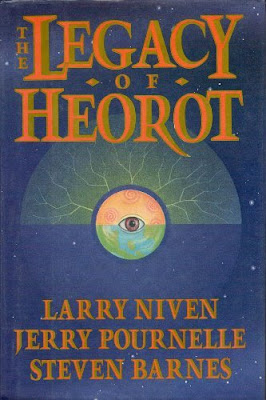1987
The Legacy of Heorot is a collaboration between Larry Niven and a couple other scifi authors.
Like A Mote in God's Eye, it features humans encountering aliens who've taken evolutionary paths that make them especially dangerous. But in Mote, the humans were all roughly equals, and nearly the whole book was written like a mystery as they tried to understand the aliens. Heorot has less mystery, more fighting, and more conservative politics.
Heorot tells the story of the human colony on planet Avalon, as they encounter the native apex predator, which they call 'grendels.' The colony's security officer, and eventual wartime leader, is Cadmann.
In the first third of the book, the colonists think they're alone on the island, with just some 'fish' in the rivers. Cadmann worries about security and perceives signs of a predator. The other colonists think he's paranoid, and when someone dies, they think he faked the attack. Then a giant grendel ransacks the camp and kills several more people.
In the second third, the Cadmann goes off to be a hermit, the colonists make repairs and let him know they defer to his judgement, and everyone tries to figure out how grendels work. There's a second attack, they learn some biology, they go wipe out the half-dozen remaining grendels, and then realize they've made a mistake.
The fish are actually 'tadpoles' and the grendels are 'frogs'. The adults lay eggs that become fish-like youths. The youths eat plants, the adults eat youths, and the very few surviving youths become adults. And with all the old adults dead, all the current youths are maturing into grendels.
The final third of the book is the interminable final battle, led by Cadmann.
The biggest problem with the book is the authors' hero worship of Cadmann. The colonists make mistakes in dealing with the grendels, but so does Cadmann. His hermit house, which becomes their siege fort, has a stream running through it... and grendels are amphibious river dwellers... But Cadmann's mistakes are because grendels are alien and mysterious, while the other colonists' mistakes are because they're too liberal and decadent to submit to his genius.
The whole structure of the book is set up to create a scenario where Cadmann is objectively right, the only correct government is military dictatorship by him, and everyone who disagrees gets eaten by a monster for failing to heed his wise counsel. Most of the colonists literally have brain damage caused by cryogenic hibernation in space, but Cadmann's mind, like his physique, remains pristine.
The whole situation is
so slanted in favor of making the way Cadmann wanted to organize society from the start the
only correct way to survive the grendel attacks that it reminds me of this essay by Corey Doctorowt reminds me of
this essay by Corey Doctorow. As Doctorow notes, despite the convolutions the authors have to go through to make
their way seem like the
right way, even in a fiction they control, the authors themselves, and some portion of their readership, seem to treat stories like this like they're a persuasive argument that real-world society should be organized the same way.
The first third would've been better if the reader thought Cadmann might be faking a monster attack because he's paranoid, bored, and wants to force the others to listen to him - but the authors show you he's right before he knows it himself. And the last battle is much, much too long. Making it shorter, instead of forcing the audience to bear witness to Cadmann's tactical brilliance, would've helped a lot.
Also, the main personal stories revolve around the various women who want to sleep with Cadmann, and the one he most wants to but can't, because of her jealous husband. He does sleep with the others, but his truest love remains unconsummated, which is treated as a noble tragedy.
There's a sequel, but I won't be reading it.











